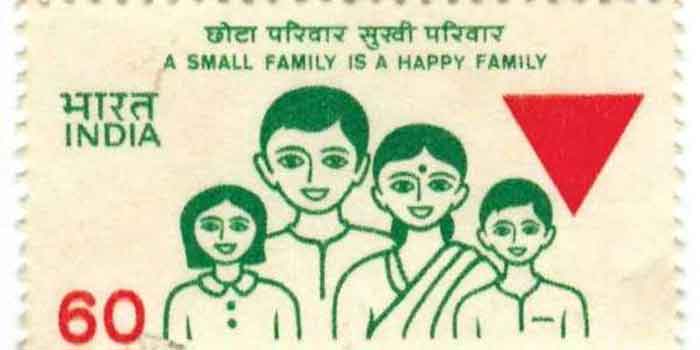
Family Planning was a lynchpin of our health services at one point of time especially in the seventies and it almost resulted in health services becoming an ancillary and essential health programs getting overshadowed by intensive drives and forcible sterilizations. This also led to negative stereotyping of health services in many states of India. India evolved a comprehensive national population policy in April 1967 which however was not followed in letter and spirit. The well-known slogan ‘development is the best contraceptive’ declared by Karan Singh in the 1974 Bucharest Population conference was lauded by many as a change of vision but did not result in programmatic changes which continued to be focused on female sterilizations and intensive drives and which ended up in forcible sterilizations during the emergency period between 1975 and 1977. It was the Karunakaran Committee set up in 1992 by the National Development Council (NDC) which recommended the formulation of another National Population Policy. The process of formulating the policy was then started by a committee headed by M.S Swaminathan and it gave impetus to development and underlined the linkages between overall development, wellbeing and population growth. The policy was declared in 2000 after several revision which probably recognised the so-called atrocities carried out in the name of sterilizations and their impact on the quality of health and family planning program. The Policy states that the “immediate objective of the NPP 2000 is to address the unmet needs for contraception, healthcare infrastructure, and health personnel, and to provide integrated service delivery for basic reproductive and child healthcare”.
For a long time, the family planning program took a backseat or it was not explicitly carried out. It underwent many changes and ‘over the decades, the programme has undergone transformation in terms of policy and actual programme implementation and currently being repositioned to not only achieve population stabilization goals but also promote reproductive health and reduce maternal, infant & child mortality and morbidity’. It was integrated into an international framework of Sexual and Reproductive health. The Government of India’s National Family Planning Programme started offering various services on a voluntary basis and even launched Mission Parivar Vikas Programme which focuses on improving access to contraceptives and family planning services in 145 high fertility districts in seven States. In addition, it also targets newly married couples through ‘humdo’ program which aims to provide eligible couples with information and guidance on family planning methods and services available, to ensure individuals and couples lead a healthy, happy and prosperous life.
The National Health Policy 2017 has largely given emphasis on overall health and wellbeing while the issue of population stabilization is limited to one paragraph. It says “ the National Health Policy recognises that improved access, education and empowerment would be the basis of successful population stabilization. The policy imperative is to move away from camp based services with all its attendant problems of quality, safety and dignity of women, to a situation where these services are available on any day of the week or at least on a fixed day. Other policy imperatives are to increase the proportion of male sterilization from less than 5% currently, to at least 30% and if possible much higher”.
International policies and strategies are becoming prominent and active as there is a feeling among scholars that the family planning program has become realistic with the recognition that intensive drives and camps may not work. The current thinking is in terms focusing on males and the youth as they think that India has not yet achieved its family planning goals (Muttreja and Singh, 2018). International business and technical corporations, aid agencies and foundations are still active in family planning in many Asian and African countries by promoting their vision through funding the development of newer contraceptives (the so-called more modern methods of contraception like injectables and pills), supporting research and publications and data collection which appear to be ‘innocent micro data’ regarding variety of indices related to families. The Rand corporation which in 1998 argued for continued support to curtail population growth with United States expertise is still involved in assisting data generation and surveys in several countries. The National Family Health Survey-5 recently came out with its key findings (NFHS 5). The NFHS is largely supported by the United States Agency for International Development (USAID) while another US agency called ICF International is involved in providing technical expertise. The NFHS data which covers a large number of variables linked to the existing evidence regarding fertility correlates. The data give special focus on family planning, fertility, use of family planning methods, access to services etc. but also collects some general socio-economic and health data in the process from 22 states and Union Territories. The data is useful largely for undertaking household-level analysis and for interstate comparisons. A number of researchers use them for variety of objectives probably oblivious of its politics and unstated purpose of indirect international monitoring of population growth. This gives an idea of how the Indian families behave!
Evidently, the ‘proliferating poor’ ideology is still relevant with the politics of family planning moving into another level of indirect entry into State machineries through provision of expertise, promotion and data gathering.
K Rajasekharan Nayar is affiliated to Global Institute of Public Health and Santhigiri Research Foundation, Thiruvananthapuram, Kerala
Sources:
Julie DaVanzo and David M. Adamson, Family Planning in Developing Countries: An Unfinished Success Story. Santa Monica, CA: RAND Corporation, 1998. https://www.rand.org/pubs/issue_papers/IP176.html.
https://www.nhp.gov.in/national-programme-for-family-planning_pg
Mission Parivar Vikas Guidelines 2016. New Delhi: Ministry of Health and Family Welfare, Government of India; 2016. National Health Mission.
Poonam Muttreja and Sanghamitra Singh. Family Planning in India: The way forward
Indian J Med Res. 2018 Dec; 148(Suppl 1): S1–S9.
SIGN UP FOR COUNTERCURRENTS DAILY NEWSLETTER
 RSS Feed
RSS Feed















 December 16th, 2020
December 16th, 2020  Awake Goy
Awake Goy  Posted in
Posted in  Tags:
Tags: 













